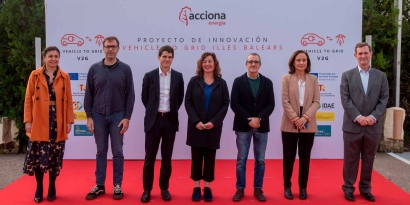
Attendees to the presentation of the project included the President of the Balearic Government, Francina Armengol, and the Director of Corporate Development and Strategy of ACCIONA Energía, José Entrecanales, accompanied by the Vice-President of the Balearic Islands Government, Juan Pedro Yllanes, and the Innovation Director of ACCIONA Energía, Belén Linares. The event also included the participation of Isabel del Olmo, Head of the Sustainable Mobility Department of the Institute for Energy Diversification and Saving (IDAE), the entity that has funded the project through the MOVES Singulares II program, and the Mayor of Manacor, Miquel Oliver Gomila.
The V2G Balearic Islands demo project involves eight Balearic companies that will install 16 charging points. ACCIONA Energía has provided participating entities with eight electric cars with V2G technology that can also be used as storage systems for self-consumption or to feed electricity back into the grid. The organizations participating in the first stage are Pavimentos Lloseta, Cárnicas Súñer, Droperba, Asociación Estel de Llevant, Hotel La Reserva Rotana and Hermanas Buades. Two companies more will join a second imminent phase, expanding the V2G network to the islands of Menorca and Ibiza.
This innovation pilot project marks the first implementation of V2G technology on an industrial scale in Spain, with a sufficient dimension to establish patterns of behavior and use. The conclusions drawn will allow to advance in the technological and economic maturity of this energy service model.
The interaction between the electric vehicles and the network will be fully digitalized, allowing to operate and supervise the delivery of electricity in both directions and analyze the performance of the charging and injection processes. This experience will enable ACCIONA Energía to monitor the main variables of V2G operations and to test and validate applications such as complementary services to the grid, or the stabilization of demand peaks, among others.
Vehicle to Grid (V2G) refers to the technology that enables a two-way communication between an electric vehicle and the grid. This communication makes it possible to use the battery of an electric car to power the vehicle’s traction, to push back the energy from the battery to the power grid, or to inject it into self-consumption systems, with the vehicle becoming an electricity supplier. The battery can be used for consumption or for supply, depending on parameters at a given time such as the level of electricity demand, the price of electricity or the technical conditions of the grid.
A V2G fleet can, for example, help the grid to cover demand peaks without the need to rely on fossil fuel plants, be an emergency solution in the event of sudden blackouts, consume electricity when the price of energy is cheaper, feed self-consumption systems, and provide adjustment services to the grid to maintain the necessary technical balance, among other applications.
In addition, some of these services are paid, so a vehicle with a V2G charging system can generate income for its owner while parked in the garage.
V2G technology is still at an early stage of development. The equipment and devices exist, but the technology still needs to mature, the regulatory framework needs to be established in a clear and enabling manner, and the penetration of electric mobility needs to be extended to make V2G a feasible and economically competitive option.
Francina Armengol, President of the Government of the Balearic Islands, expressed her gratitude for the choice of the Balearic Islands to develop “an ambitious project that is committed to clean energy and decarbonization”, a choice that “is no coincidence, because we are an autonomous community that is at the forefront in energy matters in Spain”. Armengol also stressed that “the energy transition is a challenge for us all as society, and we can only progress to a greener and more sustainable future with the involvement of all, the private sector, the public institutions, and each of us as individuals. The V2G project is a clear example of public-private collaboration to promote a more efficient and sustainable energy model.”
Juan Pedro Yllanes remarked that "this project is in line with the objectives of the Balearic Islands and the Law on Climate Change and Energy Transition. The Government of the Balearic Islands is firmly committed to promoting a change in the way we move. Mobility is the main energy consumer on the islands and the main source of CO₂ emissions. The energy transition is not only about implementing renewables to replace a polluting energy source with a clean one. The energy transition needs to go beyond that and involve major changes in the way we consume energy, and that implies addressing mobility. This project, if implemented on a large scale, would allow us to make a major quantitative and qualitative progress in the decarbonization of our energy model.”
José Entrecanales, Director of Corporate Development and Strategy of ACCIONA Energía, said that "bi-directional charging networks fit within ACCIONA Energía's strategy to provide solutions that reinforce the versatility of renewable energies in the grid and the decarbonization of transport. Our pioneering spirit leads us to commit to innovation projects like this one, which help to scale-up a new generation of renewable technologies and a more efficient and sustainable energy model.”
Isabel del Olmo, Head of the Sustainable Mobility Department of IDAE, highlighted that “this project, selected by the MOVES Singulares II program, has been highly valued for its innovative nature, its replicability and scalability. Such developments are a step forward to demonstrate that electric vehicles entail more than mere mobility. They can improve energy efficiency and allow to manage electric demand and level the grid load down, optimizing power generation and stabilizing the grid thanks to their batteries and bidirectional charging systems.”

